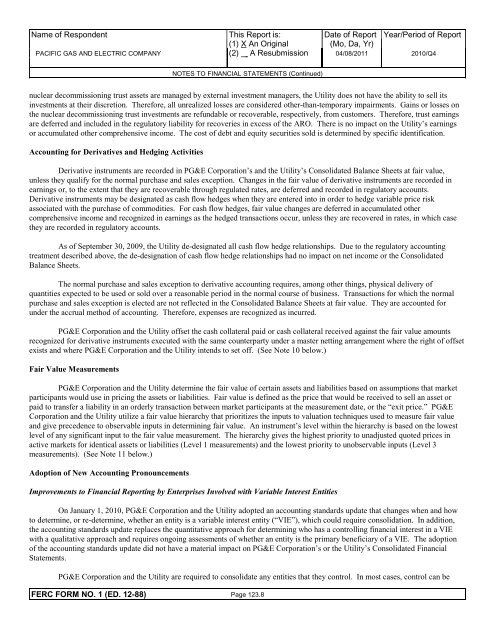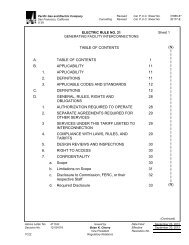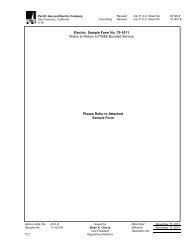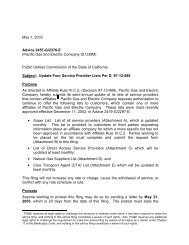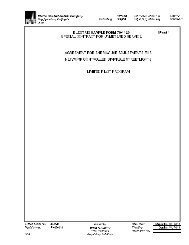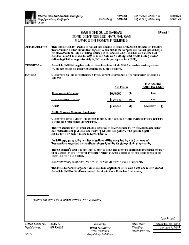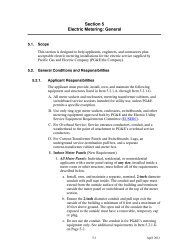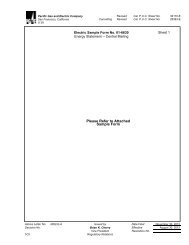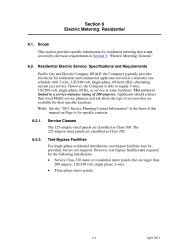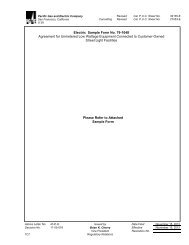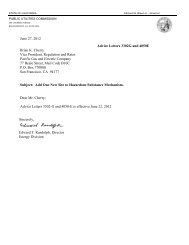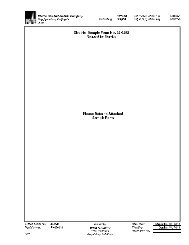2010 FERC Form 1 - Pacific Gas and Electric Company
2010 FERC Form 1 - Pacific Gas and Electric Company
2010 FERC Form 1 - Pacific Gas and Electric Company
You also want an ePaper? Increase the reach of your titles
YUMPU automatically turns print PDFs into web optimized ePapers that Google loves.
Name of Respondent<br />
PACIFIC GAS AND ELECTRIC COMPANY<br />
This Report is:<br />
(1) X An Original<br />
(2) A Resubmission<br />
Date of Report<br />
(Mo, Da, Yr)<br />
04/08/2011<br />
Year/Period of Report<br />
<strong>2010</strong>/Q4<br />
NOTES TO FINANCIAL STATEMENTS (Continued)<br />
nuclear decommissioning trust assets are managed by external investment managers, the Utility does not have the ability to sell its<br />
investments at their discretion. Therefore, all unrealized losses are considered other-than-temporary impairments. Gains or losses on<br />
the nuclear decommissioning trust investments are refundable or recoverable, respectively, from customers. Therefore, trust earnings<br />
are deferred <strong>and</strong> included in the regulatory liability for recoveries in excess of the ARO. There is no impact on the Utility’s earnings<br />
or accumulated other comprehensive income. The cost of debt <strong>and</strong> equity securities sold is determined by specific identification.<br />
Accounting for Derivatives <strong>and</strong> Hedging Activities<br />
Derivative instruments are recorded in PG&E Corporation’s <strong>and</strong> the Utility’s Consolidated Balance Sheets at fair value,<br />
unless they qualify for the normal purchase <strong>and</strong> sales exception. Changes in the fair value of derivative instruments are recorded in<br />
earnings or, to the extent that they are recoverable through regulated rates, are deferred <strong>and</strong> recorded in regulatory accounts.<br />
Derivative instruments may be designated as cash flow hedges when they are entered into in order to hedge variable price risk<br />
associated with the purchase of commodities. For cash flow hedges, fair value changes are deferred in accumulated other<br />
comprehensive income <strong>and</strong> recognized in earnings as the hedged transactions occur, unless they are recovered in rates, in which case<br />
they are recorded in regulatory accounts.<br />
As of September 30, 2009, the Utility de-designated all cash flow hedge relationships. Due to the regulatory accounting<br />
treatment described above, the de-designation of cash flow hedge relationships had no impact on net income or the Consolidated<br />
Balance Sheets.<br />
The normal purchase <strong>and</strong> sales exception to derivative accounting requires, among other things, physical delivery of<br />
quantities expected to be used or sold over a reasonable period in the normal course of business. Transactions for which the normal<br />
purchase <strong>and</strong> sales exception is elected are not reflected in the Consolidated Balance Sheets at fair value. They are accounted for<br />
under the accrual method of accounting. Therefore, expenses are recognized as incurred.<br />
PG&E Corporation <strong>and</strong> the Utility offset the cash collateral paid or cash collateral received against the fair value amounts<br />
recognized for derivative instruments executed with the same counterparty under a master netting arrangement where the right of offset<br />
exists <strong>and</strong> where PG&E Corporation <strong>and</strong> the Utility intends to set off. (See Note 10 below.)<br />
Fair Value Measurements<br />
PG&E Corporation <strong>and</strong> the Utility determine the fair value of certain assets <strong>and</strong> liabilities based on assumptions that market<br />
participants would use in pricing the assets or liabilities. Fair value is defined as the price that would be received to sell an asset or<br />
paid to transfer a liability in an orderly transaction between market participants at the measurement date, or the “exit price.” PG&E<br />
Corporation <strong>and</strong> the Utility utilize a fair value hierarchy that prioritizes the inputs to valuation techniques used to measure fair value<br />
<strong>and</strong> give precedence to observable inputs in determining fair value. An instrument’s level within the hierarchy is based on the lowest<br />
level of any significant input to the fair value measurement. The hierarchy gives the highest priority to unadjusted quoted prices in<br />
active markets for identical assets or liabilities (Level 1 measurements) <strong>and</strong> the lowest priority to unobservable inputs (Level 3<br />
measurements). (See Note 11 below.)<br />
Adoption of New Accounting Pronouncements<br />
Improvements to Financial Reporting by Enterprises Involved with Variable Interest Entities<br />
On January 1, <strong>2010</strong>, PG&E Corporation <strong>and</strong> the Utility adopted an accounting st<strong>and</strong>ards update that changes when <strong>and</strong> how<br />
to determine, or re-determine, whether an entity is a variable interest entity (“VIE”), which could require consolidation. In addition,<br />
the accounting st<strong>and</strong>ards update replaces the quantitative approach for determining who has a controlling financial interest in a VIE<br />
with a qualitative approach <strong>and</strong> requires ongoing assessments of whether an entity is the primary beneficiary of a VIE. The adoption<br />
of the accounting st<strong>and</strong>ards update did not have a material impact on PG&E Corporation’s or the Utility’s Consolidated Financial<br />
Statements.<br />
PG&E Corporation <strong>and</strong> the Utility are required to consolidate any entities that they control. In most cases, control can be<br />
<strong>FERC</strong> FORM NO. 1 (ED. 12-88) Page 123.8


